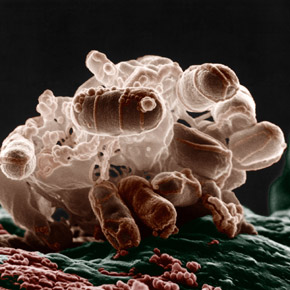Skip to comments.
Subtle Shifts, Not Major Sweeps, Drove Human Evolution
Science News ^
| February 17, 2011
| U of Chicago Medical Center, via EurekAlert
Posted on 02/21/2011 2:29:58 PM PST by SunkenCiv
The most popular model used by geneticists for the last 35 years to detect the footprints of human evolution may overlook more common subtle changes, a new international study finds.
Classic selective sweeps, when a beneficial genetic mutation quickly spreads through the human population, are thought to have been the primary driver of human evolution. But a new computational analysis, published in the February 18, 2011 issue of Science, reveals that such events may have been rare, with little influence on the history of our species.
By examining the sequences of nearly 200 human genomes, research led by Ryan Hernandez, PhD, assistant professor of Bioengineering and Therapeutic Sciences at the University of California at San Francisco, found new evidence arguing against selective sweeps as the dominant mode of human adaptation.
The reversal suggests that smaller changes in multiple genes may have been the primary driver of changes in human phenotypes, and that new models are needed to retrace the genetic steps of evolution.
"Our findings suggest that recent human adaptation has not taken place through the arrival and spread of single changes of large effect, but through shifts of frequency in many places of the genome," said Molly Przeworski, PhD, professor of Human Genetics and Ecology & Evolution at the University of Chicago and co-senior author of the paper. "It suggests that human adaptation, like most common human diseases, has a complex genetic architecture."
Under the classic selective sweep model, a new, advantageous gene appears and quickly spreads through the population. Because of its rapid rise, the gene becomes fixed in the genome with less variation than a gene that spread more slowly and was subject to the shuffling effects of recombination.
(Excerpt) Read more at sciencedaily.com ...
TOPICS: History; Science; Travel
KEYWORDS: evolution; godsgravesglyphs; helixmakemineadouble
related recent topic:
related recent article (offsite):
1
posted on
02/21/2011 2:30:04 PM PST
by
SunkenCiv
To: colorado tanker; StayAt HomeMother; Ernest_at_the_Beach; 1010RD; 21twelve; 24Karet; ...
2
posted on
02/21/2011 2:34:41 PM PST
by
SunkenCiv
(The 2nd Amendment follows right behind the 1st because some people are hard of hearing.)
To: SunkenCiv
——advantageous gene appears and quickly spreads through the population. ——
The gene doesn’t spread through the population. The population with the gene grows because it is favorable and is transmitted widely over time
It is a gene, not a virus
Uncertainty is the mark of a keen mind
3
posted on
02/21/2011 2:42:51 PM PST
by
bert
(K.E. N.P. N.C. D.E. +12 ....( History is a process, not an event ))
To: bert
4
posted on
02/21/2011 2:57:01 PM PST
by
SunkenCiv
(The 2nd Amendment follows right behind the 1st because some people are hard of hearing.)
To: bert

8 percent of human genes come from virus
http://www.topnews.in/8-percent-human-genes-come-virus-2250962
5
posted on
02/21/2011 3:09:02 PM PST
by
JoeProBono
(A closed mouth gathers no feet - Visualize)
To: SunkenCiv
Yes, of course it is “rare”. Just the latest part of evolutionary theory to come into question.
Where is the list of beneficial mutations that connect our common ancesters to both chimps and humans? That should be an obvious outgrowth of genome mapping. If evolution is true, there must exist a series of trivial mutations, starting with the common ancester, each of which is a viable and reproducable creature.
Otherwise, you can’t get from “there” to “here”. It’s like Google giving you directions from Japan to China.
To: JoeProBono
Yes but.......
The virus does not mutate the same gene throughout an existing population. The virus gene is transmitted forward into the population by sex with the person into whom it mutated
7
posted on
02/21/2011 4:41:23 PM PST
by
bert
(K.E. N.P. N.C. D.E. +12 ....( History is a process, not an event ))
Disclaimer:
Opinions posted on Free Republic are those of the individual
posters and do not necessarily represent the opinion of Free Republic or its
management. All materials posted herein are protected by copyright law and the
exemption for fair use of copyrighted works.
FreeRepublic.com is powered by software copyright 2000-2008 John Robinson

